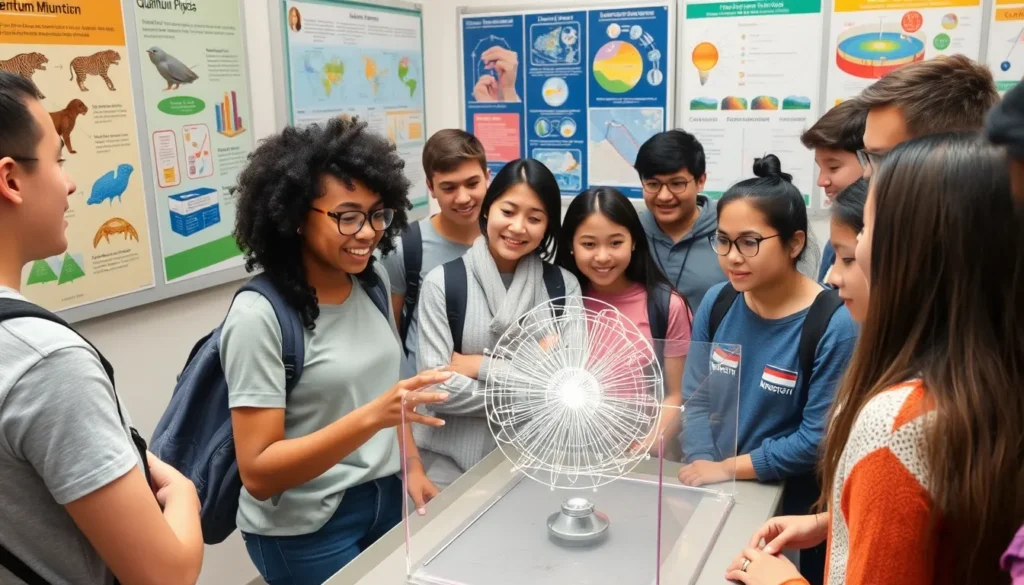In a world overflowing with information, scientific content stands out like a unicorn at a dog park. It’s the gold standard for knowledge seekers who crave facts, insights, and a sprinkle of wonder. Whether it’s the latest breakthrough in medicine or a deep dive into quantum physics, scientific content transforms complex ideas into digestible bites that even your grandma could understand—if she’s into that sort of thing.
Scientific Content
Scientific content stands out in a crowded information landscape. Its role as a credible knowledge source proves essential in today’s society. Writers often prioritize accuracy, presenting facts clearly and understandably. Research articles, reviews, and educational materials comprise the core types of scientific content. Each type caters to various audiences, broadening its reach and impact.
In academic fields, journals publish peer-reviewed studies. These articles offer in-depth insights into specific topics, allowing experts to share discoveries with colleagues. Educational content thrives in classrooms and online courses, enabling learners to grasp concepts effectively. Science blogs and popular science books simplify complex ideas, appealing to non-specialists.
Clear communication fosters understanding. When writers present data, they often use visuals like graphs and charts. These tools help to convey intricate findings succinctly. Lists, tables, and bullet points break down information, making it easily digestible. Within scientific writing, transparency regarding methodologies and results strengthens trust.
Accessibility remains a primary focus for creators of scientific content. Open-access platforms have emerged, encouraging broader dissemination of research findings. Various online resources offer free educational materials, enhancing public knowledge. Ultimately, scientific content plays a vital role in bridging gaps between experts and the general public, encouraging informed discussions around critical issues.
Importance of Scientific Content

Scientific content holds significant value in an information-saturated world. It provides essential knowledge and insights, ensuring informed decision-making across diverse audiences.
Educational Value
Educational value stems from the clarity and accessibility of scientific content. Research articles, reviews, and educational materials cater to different learning styles. They enable students and professionals to explore intricate concepts systematically. For instance, structured lesson plans incorporate scientific findings into classroom discussions. By utilizing engaging methods, participants comprehend complex topics better. Relevant case studies exemplify real-world applications, enhancing understanding. Overall, scientific materials foster critical thinking skills and spark curiosity in learners.
Public Understanding of Science
Public understanding of science relies on clear communication and reliable information. Accessible scientific content informs citizens about pressing issues such as climate change and health. This knowledge empowers individuals to engage in informed discussions and advocacy efforts. Simplifying complex ideas ensures non-specialists grasp key concepts easily. Furthermore, open-access platforms expand reach and encourage widespread consumption. Science blogs and popular publications play a crucial role in bridging the gap between experts and the public. These resources stimulate interest in scientific literacy, ultimately leading to a more informed society.
Types of Scientific Content
Scientific content encompasses a variety of formats, each serving unique purposes and audiences. Key types include research articles, educational materials, and popular science representations.
Research Articles
Research articles represent the backbone of scientific communication. Peer-reviewed studies published in academic journals deliver detailed insights into specific topics, presenting original research and findings. These articles include methodologies, results, and discussions that engage experts and scholars. Readers gain access to robust data and are often invited to scrutinize methodologies and conclusions. Research articles contribute to the advancement of knowledge, ensuring transparency and reproducibility in scientific endeavors.
Educational Materials
Educational materials play a crucial role in facilitating learning and comprehension. They include textbooks, instructional guides, and online course content designed to simplify complex subjects. Well-structured lesson plans and engaging visuals aid in the understanding of intricate concepts. These resources cater to various learning styles, ensuring accessibility for both students and educators. Effective educational content empowers individuals to explore scientific topics deeply, encouraging critical thinking and curiosity.
Popular Science Representations
Popular science representations bridge the gap between expert knowledge and public understanding. Science blogs, articles, and books use accessible language to simplify complex ideas for a general audience. Engaging narratives and relatable examples draw readers into scientific discussions. This format enhances the understanding of pressing issues like climate change and health through storytelling. By making science approachable, these representations stimulate interest and foster informed conversations among non-specialists.
Quality Assessment of Scientific Content
Quality assessment ensures that scientific content provides accurate and credible information. Several aspects contribute to the evaluation of scientific works, focusing on the peer review process and factors influencing credibility.
Peer Review Process
Peer review serves as a cornerstone of scientific integrity. Submissions undergo scrutiny from experts in the relevant field, enhancing the reliability of published studies. This process typically involves critical feedback, revisions, and a final approval stage before dissemination. Rigorous evaluation ensures research adheres to established standards. Reviewers assess methodologies, data interpretation, and conclusions drawn from findings. Successful peer review confirms the work’s validity, making it trustworthy for scholars and practitioners alike.
Factors Influencing Credibility
Multiple factors impact the credibility of scientific content. The author’s qualifications, such as education and experience, play a significant role. Reputable journals publishing the work contribute to perceived reliability. Furthermore, citations reflect the study’s engagement with existing research, indicating its academic contribution. Transparency in methodology allows for reproducibility, establishing trust. Lastly, alignment with ethical standards fortifies credibility. Thorough examination of these elements aids readers in discerning quality scientific information.
Challenges in Creating Scientific Content
Creating scientific content poses several challenges, impacting clarity and accessibility. Addressing these hurdles is crucial for effective communication.
Misinterpretation of Data
Misinterpretation of data often arises from complex statistical terminology. Readers unfamiliar with advanced concepts may draw incorrect conclusions. Including simplified explanations can enhance understanding for a broader audience. Additionally, overgeneralizing findings creates further confusion. Distinctly presenting limitations alongside results helps readers grasp the study’s scope. Furthermore, providing context around data allows for better comprehension of its significance. Ensuring transparency in presentation, such as specifying sample sizes or variables, strengthens the content’s credibility. These techniques minimize misinterpretation and promote accurate understanding.
Accessibility Issues
Accessibility issues frequently hinder the reach of scientific content. Many scientific papers utilize dense language, posing barriers for the general public. Simplifying terminology is essential, making scientific concepts approachable for all audiences. Moreover, visual aids like infographics enhance comprehension and engage readers effectively. Online platforms play a vital role in democratizing access to valuable information. Implementing open-access models improves availability of research findings. Ensuring compatibility with various devices further supports accessibility. Additionally, catering to diverse learning styles, through varied formats and engaging materials, fosters greater understanding. These strategies create a more inclusive environment for scientific discourse.
Conclusion
Scientific content stands as a beacon of clarity in an age of information overload. Its role in fostering understanding and promoting informed discussions cannot be overstated. By bridging the gap between experts and the public, it empowers individuals to engage with critical issues effectively.
The commitment to accuracy and accessibility in scientific writing not only enhances public knowledge but also inspires curiosity and critical thinking. As the landscape of information continues to evolve, the importance of high-quality scientific content will only grow, making it essential for a well-informed society.



